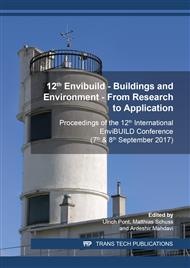p.303
p.311
p.319
p.327
p.335
p.344
p.353
p.361
p.369
Assessment of the Life Cycle Energy Efficiency of a Primary School Building in Turkey
Abstract:
Energy efficiency has become a crucial part of human life, which has an adverse impact on the social and economic development of any country. In Turkey, it is a critical issue especially in the construction sector due to increase in the dependency on the fuel demands. The energy consumption, which is used during the life cycle of a building, is a huge amount affected by the energy demand for material and building construction, HVAC and lighting systems, maintenance, equipment, and demolition. In general, the Life Cycle Energy (LCE) needs of the building can be summarised as the operational and embodied energy together with the energy use for demolition and recycling processes.Besides, schools alone are responsible for about 15% of the total energy consumption of the commercial building sector. To reduce the energy use and CO2 emission, the operational and embodied energy of the buildings must be minimised. Overall, it seems that choosing proper architectural measures for the envelope and using low emitting material can be a logical step for reducing operational and embodied energy consumptions.This paper is concentrated on the operating and embodied energy consumptions resulting from the application of different architectural measures through the building envelope. It proposes an educational building with low CO2 emission and proper energy performance in Turkey. To illustrate the method of the approach, this contribution illustrates a case study, which was performed on a representative schoold building in Istanbul, Turkey. Energy used for HVAC and lighting in the operating phase and the energy used for the manufacture of the materials are the most significant parts of embodied energy in the LCE analyses. This case study building’s primary energy consumption was calculated with the help of dynamic simulation tools, EnergyPlus and DesignBuilder. Then, different architectural energy efficiency measures were applied to the envelope of the case study building. Then, the influence of proposed actions on LCE consumption and Life Cycle CO2 (LCCO2) emissions were assessed according to the Life Cycle Assessment (LCA) method.
Info:
Periodical:
Pages:
335-343
Citation:
Online since:
January 2019
Authors:
Price:
Сopyright:
© 2019 Trans Tech Publications Ltd. All Rights Reserved
Share:
Citation:


